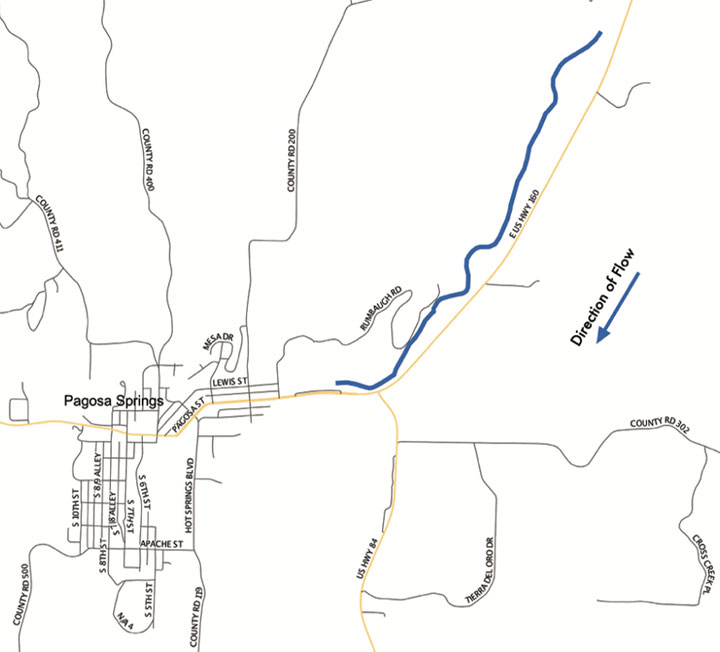A couple of Daily Post readers contacted me about something I’d written in Part Four of my editorial series, “EDITORIAL: The Preservation of Aquatic Life in Archuleta County.”
I’d written:
A curious thing about Colorado Rivers. The stream bed and river banks legally belong to the adjacent property owners, so members of the public will not be free to fish from the shore or walk in the stream bed, anywhere along this 3-mile stretch, without permission from the property owners. Anyone can float down the river, but we cannot set a foot on the earth without owners’ permission…
When I wrote that paragraph, I had not done any research into this question. The statement was based on what you might call “common knowledge” for folks who’ve lived in Pagosa for a couple of decades. Of course, “common knowledge” is not always accurate, just as “scientific knowledge” is not always accurate.
Even “legal knowledge” is not always accurate.
But… if my information was accurate… then the government entities that are lining up to throw money at a $2 million “stream enhancement” project aimed at a three-mile stretch north of downtown Pagosa Springs, probably ought to be having some conversations about who, exactly, this $2 million investment is going to benefit. The project has been proposed by the semi-public Upper San Juan Watershed Enhancement Partnership (“the WEP”), which is supported by Durango-based Mountain Studies Institute.
To my knowledge — based upon hearing presentations of the proposed “enhancement” project at three different meetings — these conversations about river access have not yet taken place. But taxpayer funding has nevertheless been promised.

Nor is it clear whether Mountain Studies Institute or the WEP has obtained ‘buy-in’ for this project from the private property owners who ‘own’ this particular stretch of the San Juan River.
One of our readers sent me several online links that touch on the question: “Does a private property owner also own the river banks and stream bed, when a river flows through his or her property?” In Colorado, this would appear to be the case, although it’s not quite so true in, for example, Montana or Utah.
The laws and court decisions governing the ownership of riverbanks and river beds in various U.S. states are a bit of a mess, and maybe that’s intentional. Or maybe it’s a mess because everything naturally tends to get messy. Entropy and so on.
In the case of People v Emmert, the Colorado Supreme Court determined, in 1979, that three recreational rafters had violated trespass laws when they floated down the Colorado River through a private ranch without first obtaining the property owner’s permission to do so. The decision was built upon the common law concept of “cujus est solum, ejus est usque ad coelum”…
The common law rule holds that he who owns the surface of the ground has the exclusive right to everything which is above it (“cujus est solum, ejus est usque ad coelum”). This fundamental rule of property law has been recognized not only judicially but also by our General Assembly when in 1937 it enacted what is now codified as section 41-1-107, C.R.S. 1973:
“The ownership of space above the lands and waters of this state is declared to be vested in the several owners of the surface beneath, subject to the right of flight of aircraft.”
https://law.justia.com/cases/colorado/supreme-court/1979/28235.html
Although the Colorado Constitution defines the waters of the state as a public resource, and protects our right to “appropriate” water for any beneficial purpose — recreation has never been defined in this state as a form of “appropriation”. In People v Emmert, the Colorado Supreme Court ruled that recreational activities were not protected by the Constitution. To wit:
Thus, in Hartman, supra, ownership of the stream bed was held to include the exclusive right of fishery in the waters flowing over it. It follows that whoever … intrudes upon the space above the surface of the land without the permission of the owner, whether it be for fishing or for other recreational purposes, such as floating, as in this case, commits a trespass.
In 1983, Colorado Attorney General Woodard wrote an opinion — which is just an opinion, not settled law — that a boat floating down a Colorado river does not violate trespass laws so long as the passengers stayed in boat and doesn’t touch the banks or the stream bed.
I know that Pagosa fishing guides sometimes make agreements with property owners to allow fishing along streams located on private property, including the main stem of the San Juan River. (My son was a fishing guide one summer, here.)
I have no idea if any of Pagosa’s rafting and tubing companies have made agreements with property owners to allow travel through their properties. That would seem like the simplest way around the legal mess — for those particular companies. But any such agreements would presumably provide no legal protection for the general public who might want to float down an “enhanced” stretch of the San Juan River.
I reached out to MSI and the WEP, and sent them a pre-publication copy of this editorial — to see if they wanted to offer any comments on the public’s legal access to a potentially “enhanced” San Juan River when it runs through private property… and got a response from MSI that the partnership is not able to comment on the legal questions at this point.
I hope that, before the taxpayers fund a $2 million river enhancement project, we have a clear understand of who, exactly, will benefit from that type of expenditure.
And who won’t.

